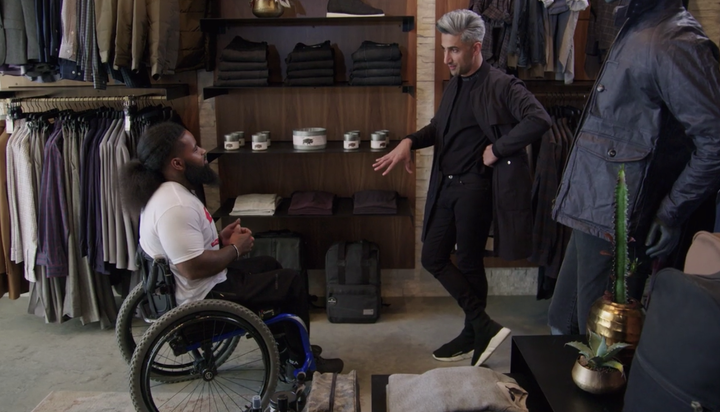
One of the things that I love most about “Queer Eye” is the way the show artfully deconstructs stereotypes by cutting through loaded and polarizing issues to tell the stories of individual people. Jonathan, Antoni, Karamo, Bobby and Tan introduce their audience to individuals and their communities with sensitivity and respect. We have never needed the Fab Five more, and personally, I adore them.
It’s my loyal fandom that made Episode 2 of the newly released Season 4 particularly disappointing. In this episode, the men helped Wesley, a Black man, loving father, 30-year-old community activist and wheelchair user based in Kansas City. He acquired his disability after being shot in the abdomen seven years ago. Now, he runs a nonprofit called “Disabled But Not Really,” which strives to increase accessibility and empowerment in fitness settings.
Wesley is kind, funny, charismatic and thoughtful. Despite my affection for this hero, I found the episode itself painful. I am a disabled woman who uses a power wheelchair, and the show missed an opportunity to make the world more equitable for those of us with disabilities.
Embracing one’s identity has been a central theme throughout all four seasons of “Queer Eye” — a direct reflection of the Fab Five’s examples of hard-won self-love. In Season 3, Jess Guilbeaux struggled with her identities as a Black woman and lesbian. The Fab Five drew from their individual experiences of accepting and embracing their own queer identities to help her do the same in an episode with the empowering title, “Black Girl Magic.” By contrast, in Wesley’s episode, they danced around themes of disability pride, accessibility, independence/interdependence and assimilation without ever aligning themselves with the values central to the disability rights movement.
My guess, based on statistics about disability representation in media, is that the producers didn’t consult with disability rights activists — much less employ them on the show — when they were developing and editing the episode. If they had, then less problematic themes would have dictated the narrative course of this episode. Critically, being disabled is not a negative. It’s an identity, just like being queer, Black or Latinx is an identity. If it makes you pause to hear “Black, but not really,” or “gay, but not really,” then you should have the same reaction to “disabled, but not really.”
Disability, as defined by the disability rights movement and even the World Health Organization, is primarily a result of society’s exclusion of different body types through architecture and policy. This framework, called the social model of disability, is empowering because it focuses our attention on the social issues affecting disabled people that need to to be addressed (like poverty rates, voting rights, access to education, adequate transportation, medical care, the prevalence of sexual assault, and employment opportunities). Disability is not defined by a lack of ability, but by a power structure that protects a particular way of having a body.
It’s tricky, of course, because Wesley himself, a disabled man, named his organization, and the organization is doing incredible work. I also don’t know whether the name is meant to imply that “disability” itself a negative label or only that society views it as such. The problem isn’t Wesley. The problem is that we so rarely see people with visible disabilities on TV, and when we do, the stories told about us often perpetuate our oppression. “Queer Eye” had an enormous responsibility with this episode because people with disabilities experience such a scarcity of representation, and it fell short. The show failed to talk in-depth about the beautiful community of disabled people educating and advocating, and instead repeated tired and oppressive tropes about disability.
“With Wesley, while they never fully encourage him to reject his identity, their overarching goal was seemingly about helping him be more “normal,” which, in this case, they equate with being able-bodied.”
Wesley is not the first person on “Queer Eye” who has experienced ambivalence around his identity. Many of the heroes have felt uncomfortable with their gender, race, sexuality or ethnicity. What matters is that the Fab Five have, without exception, encouraged the stars of all the episodes to embrace who they are. With Wesley, while they never fully encourage him to reject his identity, their overarching goal was seemingly about helping him be more “normal,” which, in this case, they equate with being able-bodied.
While they unfortunately don’t explicitly address pervasive inaccessibility, the Fab Five do allude to how difficult it can be to navigate the world and even your own home as a person with a disability. Jackets, stairs, room dimensions and appliances are all made for a certain kind of body. Wesley and his mom reference the financial struggles that are inherent in acquiring a disability (his mother lost her job and her house in the process of trying to provide him with necessary care). The show never fully leans into this version of the story, though — the one where the disability isn’t the problem, it’s how society treats people with disabilities.
In one touching scene, Tan cries as he relates his own internalized homophobia, and how he has only recently come out to some members of his family. Wesley asks him how he was able to become proud, finally, of who he is. This scene could have been an opportunity to discuss disability pride, to consider that being disabled is not inherently worse than being able-bodied, that Wesley’s body isn’t deficient, and that often the shame a disabled person experiences comes from external messaging, not who they are and how their bodies work. Instead, Wesley somehow ends up comforting Tan, and we all move on.
Of course, Wesley has the right to view disability however he would like. He is a disabled man, and it’s his life, his identity. But it’s also critical that we acknowledge the intersectional factors of his multiple identities ― as a father, a Black man, a survivor of gun violence, and a person with a disability. We also can’t expect one man’s story to represent all of us. Again, though, because there is such a dearth of disabled representation, each example carries a lot of weight. I would hope that, in the future, when “Queer Eye” features someone with a disability, they will ensure that the production and the messaging of the Fab Five align with disability rights’ core beliefs.
I am disabled, and my goal isn’t to be able-bodied. My goal is to see myself adequately represented in all spheres, including sentimental reality shows. It is not bad to be disabled. We don’t need to distance ourselves from that word.
Many people with disabilities, including me, are proud of our identity. My hope is that people with disabilities will soon be allowed the same level of safety, freedom, professional success and access to power as our non-disabled peers.
I wish that “Queer Eye” hadn’t missed this opportunity to examine ableism (including internalized ableism). I wish that the Fab Five hadn’t clinked their glasses at the end of the episode with the refrain, “Disabled, but not really. Cheers!” but instead, “Disabled and proud. Fuck yeah.”
Do you have a compelling personal story you’d like to see published on HuffPost? Find out what we’re looking for here and send us a pitch!
